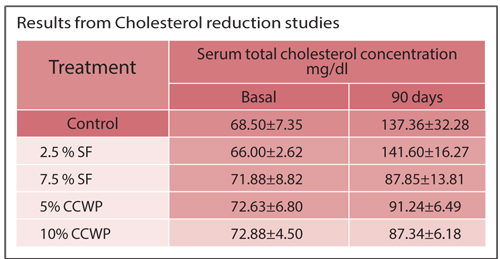Coconut as food grade fibre? What the rats tell us
Split the hard shell of a coconut, and you find a delicious milky kernel. Scrape the kernel from the nut and you get fresh coconut meat. Coconut milk is extracted from the meat with or without the addition of water. The fibrous remainder, polkudu, is usually thrown away. “Don’t throw away the polkudu,” says Dr. Chandi Yalegama, Head of the Coconut Processing Research Division at the Coconut Research Institute in Lunuwila.
Add polkudu to fresh coconut kernel when you prepare traditional Sri Lankan food such as sambol, mallum, rotti and pittu, she says. Wheat flour does not have enough fibre, so polkudu can be added to wheat flour to make food with high fibre. Make sure you store the polkudu in the refrigerator if you intend to use it later.
One of the most important plantation crops in Sri Lanka, coconut (Cocos nucifera) is not only an important commodity in households but also a source of raw material for various processing industries. Sri Lanka ranked fourth in the global production of nuts in 2018, the top four producers all being Asian countries. On a per capita basis however, Sri Lankan coconut production is a close second only to the Philippines. Of the 2.75 billion nuts produced annually, we consume 60-70% domestically.
In culinary preparations, coconut is consumed in two ways: coconut milk and coconut oil. In the extraction process of coconut milk and coconut oil, byproducts known as “polkudu” and “poonac” respectively are produced. Polkudu, which contains a considerable amount of fat, is thrown away as waste; whereas poonac, which has a lower fat content, is normally used as an animal feed. When coconut milk and coconut oil are extracted, the corresponding residue (i.e. polkudu and poonac) will still be rich in components such as protein, minerals and fibre and hence a wholesome food ingredient.
Other than coconut milk and coconut oil obtained as food ingredients from the coconut kernel, nearly all the parts of the coconut tree (leaves, trunk etc.) have various uses in the household. This is why the coconut tree is called “kap-ruka” or “kalpa-ruksha” (i.e. a tree of bounty).
Past studies on the use of coconut byproducts as food grade fibre were scanty. Therefore, a detailed study of the properties of coconut kernel byproducts was carried out to enhance its use, value addition and acceptability to consumers.
The research was designed in such a way that it studied different properties of coconut residue at various purification stages; in other words, to develop methods to isolate coconut kernel cell wall polysaccharides (CCWP), which is concentrated food grade fibre; and to characterize their functional and structural properties and nutritional effects. As in many studies that seek to predict effects of inputs on humans, the “guinea pigs” were rats, since they are small animals that are easily managed in a laboratory, but with metabolic pathways not very different to humans.
Dr. Yalegama obtained the byproduct of coconut milk (milk residue, MR or polkudu) and that of virgin coconut oil (virgin oil residue, VOR) after extracting milk and virgin coconut oil, respectively; this increased the carbohydrate content (or fibre content) by 5-fold in MR and 10.5-fold in VOR. The VOR was further processed by removing residual fat, protein and soluble sugars to isolate coconut kernel fibre (CCWP).
Feeding of the rats with 20% of polkudu (MR) achieved the lowest weight gain during the 120 days of the experiment. So polkudu in the diet was effective in weight reduction. Moreover, the serum total cholesterol concentrations of the rats fed with a diet containing MR or VOR in moderate amounts (10% or 20%) was lower than the rats fed with a diet without incorporating MR or VOR.
Fibre in the diet is good for health benefits. The VOR was used to isolate soluble and insoluble fibre of coconut kernel (SF and CCWP respectively). Adding fibre in soluble (SF) or insoluble (CCWP) form in the range 2.5-10% resulted in a decrease in serum total cholesterol compared to the rats fed without fibre (see Table).
The study showed several types of polysaccharides such as soluble fibres, pectin, hemicelluloses and celluloses and oligosaccharides (short chained polysaccharides) that can be used in food for the incorporation of fibre. It is a good source of dietary fibre, and has a commercial potential for development into fibre concentrates for lowering the lipid profile.
These research findings have the potential of benefiting the people, government and business in various ways, especially because of Sri Lanka’s large per capita coconut production.
Due to a high demand for coconut-based products in the export market, the price of coconut has increased sharply. Generous use of polkudu as a partial replacement of the scraped coconut in sambal, mallung, roti and other foods would significantly reduce the domestic consumption of coconut.
High fibre diets will maintain blood sugar and lipid profiles at a healthy level. Adopting such diets with coconut residue will make people healthier, saving the government revenue loss for treatment of diabetic and heart patients. In addition, fibre concentrates produced from coconut residue would be attractive foreign exchange earners overseas – although such concentrates have yet to be exploited commercially.
Several companies are already producing such coconut flour, the technology for which is available at the Coconut Research Institute.
The flour can be used to produce high fibre cookies and bakery products, thus adding value to industrial food production and exported to earn foreign revenue.
This research was funded by the National Research Council under grant IDG 09-15, and awarded to Dr. Chandi Yalegama at the Coconut Research Institute. Professors Nedra Karunaratne (Chemistry Department) and R. Sivakanesan (Biochemistry Department) of the University of Peradeniya supervised the research, which also led to the award of a doctoral degree to Dr. Yalegama. Asitha Jayawardena was commissioned to write this article as part of the science publicity programme of the National Academy of Sciences of Sri Lanka.




